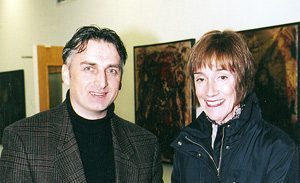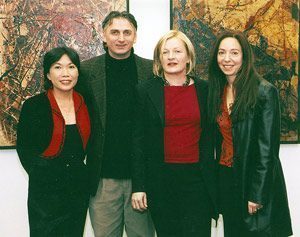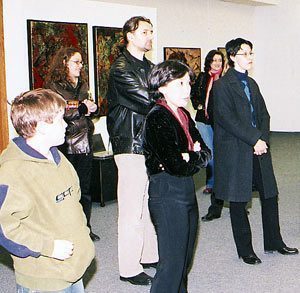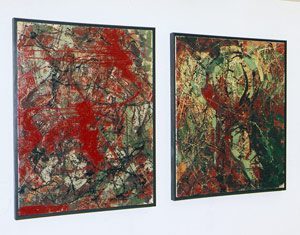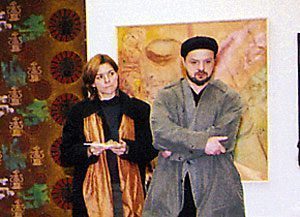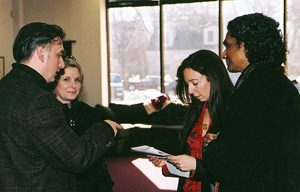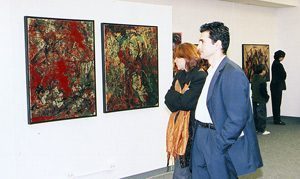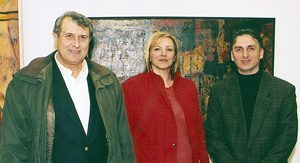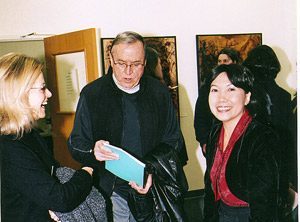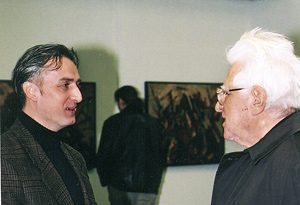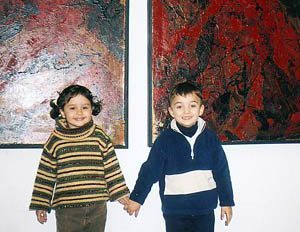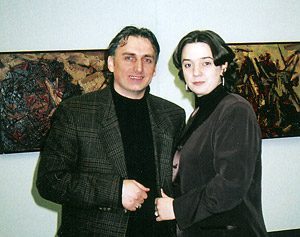Pandora Meets Sarajevo:
Reclamations for a Wounded World
Line Drive Gallery, Evanston, 13. March 2005.
Paintings by Ginny Sykes,
Duyen Thi-Phuong Nguyen, Caroline Anderson and Samir Bisevic
PANDORA MEETS SARAJEVO
Evanston, Mart 13.-April 22. 2005
EVANSTON ROUND TABLE
Art Hits Home at Line Drive Gallery
By Victoria Scott
Exhibiting artists Caroline Anderson, Samir Biscevic, Duyen Nguyen and Ginny Sykes have mounted pieces that, while expressing revulsion at war and violence, affirm the power of art to confront and redeem.
Rooted in far-flung cultures, the four artists connected through the international artists’ collaboration TransCultural Exchange. In “Pandora Meets Sarajevo” each artist strives to reclaim something lost or broken, finding universal themes in their personal experiences.
Raw pain cries out from Mr. Biscevic’s paintings. Before immigrating to the United States ten years ago, the Bosnian native suffered through the war that destroyed his country. His large canvases depict the horror of a once-tolerant society goaded to prejudice and brutality. In lurid colors and a style he describes as “abstract [yet] coming from the real world,” Mr. Biscevic lets loose the monster of his anger.
“There is no beauty,” he says of his work, “nothing nice.”
“Sarajevo” is his disturbing portrait of a ruined town once famed for multiculturalism and religious diversity. “The Wounded Soul,” splashed with red and ochre, bears the faint outline of the face of a woman whose arms encircle her head to fend off violence. “Over 50,000 women in Bosnia were raped,” he says. “It was systematic.”
At first, he says, he tried to forget the war. “When I came to the U.S.,” he says, “I painted nice landscapes.” But memories began to intrude, he says, “coming back, slowly, slowly. One day it erupts, like a volcano. It was scary. You have to do something.”People need to know, to hear the testimony,” he continues. “If you cannot do anything, you can talk about it.” What was never to happen again after World War II did happen – and “in exactly the same way,” he says, while all the world closes its eyes. His response is not optional: he must paint. “There is no choice,” he says.
A terrorist act moved Ginny Sykes to paint her tumultuous oils. Returning in 1997 to the small city of Girona, Spain -home to Muslims, Christians and Jews before the 1492 Inquisition – she hoped to shed light on her Jewish identity.
Instead, two days after her arrival, Basque separatists killed an innocent young Spaniard in Madrid. The ensuing tide of protest turned her personal quest into a seven-year search to understand, n her artistic language, how tolerance twists into intolerance, how repression breeds brutality. “Dark Day in Spain is one view of the catastrophic results.
En route to a master’s degree in women’s studies, Ms. Sykes found an explanation for intolerance in the myth of Pandora. She learned that the goddess, once known as the all-giver, was demoted by a patriarchal society to the role of giver of evil. A capacious urn, Pandora’s original attribute, shrank through the ages to a small box filled with evil.
Ms Sykes began to see the story of the goddess as a metaphor for the consequences of repression and reduction. She interprets the Pandora story, along with the Madrid tragedy, as an argument for tolerating contradiction and complexity. In paintings like “Death Is Our Companion to Hope” Ms. Sykes calls for reclaiming Pandora’s urn, along with its mixed contents, for “creat[ing] space for disparities to exist.”
Cross-cultural communication can fuel fresh insights, as it did when Ms. Sykes discovered Mr. Biscevic’s connection to Jewish prayer book. The haggadah was smuggled out of Spain by Jews who fled to Sarajevo to escape the cruelties of the Inquisition. Rescued from the Nazis by a Muslim during World War 11, the book was damaged by Serbian bombing in the 1990s. Pandora met Sarajevo when Ms. Sykes learned that Mr. Biscevic was the U.S. translator for the famous man who repaired it.Cross-pollination is the realm of Ms. Anderson, assistant director of TransCultural Exchange. At Line Drive Gallery she is showing a group of intaglio prints with Viking symbols she recently recognized in the petroglyphs of Azerbaijan. “Art has an energy separate from nationalism and narrative,” she says.
With her prints on silk and canvas, Vietnamese artist Duyen Nguyen reimagines the scroll. She says her print aim to recreate the traditional temple in two dimensions and reclaim for her native country a role beyond war.Artists Samir Biscevic, Caroline Anderson, Ginny Sykes and Duyen Nyugen at the opening of their show at Line Drive Gallery.
S. Biscevic and Victoria Scott
Nguyen, Biscevic, Anderson, Sykes
Emin Drnovsek, Nermin Dzonlagic, Emina Dervovic
Adnan and Judy Puskar
Samir, Sendy,Ginny and Ignatius
Vernes Dervovic
Mesud and Latifa Kulauzovic
Duyen Nguyen with friends
Mensur Seferovic
Zehra Dervovic and Din Biscevic
Samir and Enisa Biscevic


